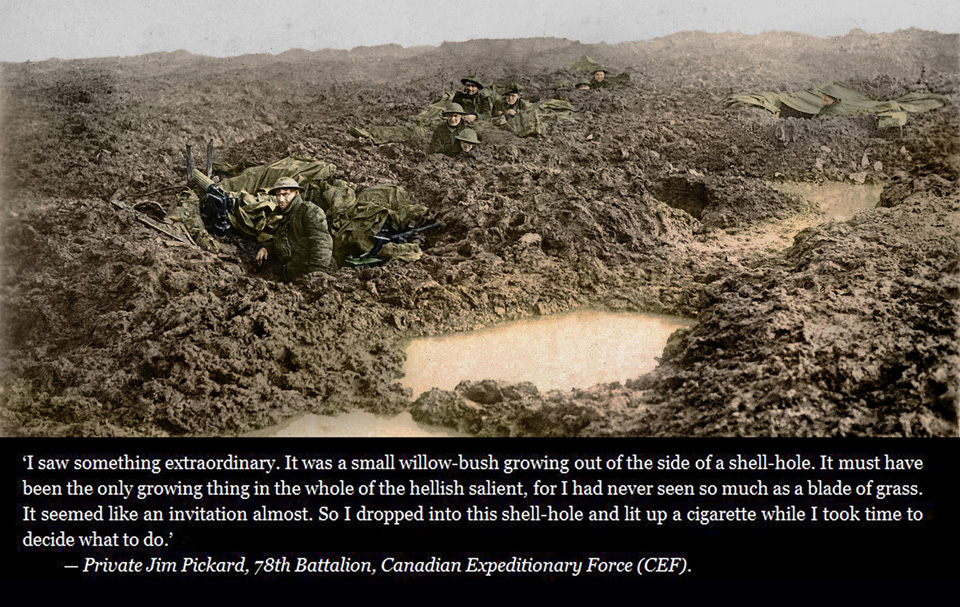
World War One Samuel Unitt 78th Battalion Canadian Expeditionary Force 1916 1917 1918 The Somme Vimy Ridge Passchendaele Amiens Valenciennes Armistice Winnipeg Grenadiers Flanders Canada Trench Warfare
World War One: A distant memory
Pte. Samuel Unitt 78th Bn, and the CEF in Flanders Fields 1915-1918












Samuel Unitt, a Canadian signalman in Flanders

|

|
My Grandfather, Samuel Unitt enlisted in the 100th Winnipeg
Grenadiers, a militia battalion, sometime after the outbreak of the First World War. The
battalion then was renamed the 78th Overseas Batallion, "The Winnipeg
Grenadiers," and he "attested" (i.e. volunteered for overseas duty
in France). Samuel Unitt was born in Redditch England and emigrated to Canada when he was 17. He was 21 when he joined the call for volunteers after the original BEF (British Expeditionary Force) in France had been decimated by the tremendous losses of the 1914 Campaign. Canada was automatically involved in the War based on being part of the Commnwealth. Great Britain was building up for a huge offensive in 1916 to break through the German trenches. In England the "pal" regiments answered the call, in Canada 30,000 men immediately enlisted. The 78th Battalion reached France by August 1916 and was then attached to the 12th infantry brigade of the newly formed 4th Canadian division of the Canadian Corps.
|
 Where is Redditch England?
|
 The Winnipeg Grenadiers
The Winnipeg GrenadiersMy Grandfather's battalion was involved in a number of famous actions, sadly I have little personal details from him as he passed when I was seven years old. Hopefully some other tidbits turn up as I post things here. The main point of this website is to share a few of his historical gems, handed down to me. The first being the Armistice note of 11/11/1918, the second being the "Demuin Map" of Lieutenant S. L. Honey, an officer of the Winnipeg Grenadiers who fell in battle, earning the Victoria Cross. Along the way my adventure of researching these materials has given a renewed respect for these soldiers who fought and died so many years ago in the "War to End All Wars."
Fortunately, my Grandfather survived the battle of the Somme, where his friend and neighbor, Raymond Woodfield perished. My Grandfather was gassed, most likely at the Somme, or Passchaendaele, or Vimy Ridge, these were famous actions where his Battlaion was heavily engaged . I have many links to the 4th Division's activity at these battles that I will post later. I am actively seeking his war record so I might pin down these details.
Training certificate for Samuel Unitt: Here is what the Fullerphone looked like, and how it
operated:
Here is an interesting side light to this
message.
Hi Jeff,
|

|
http://www.vac-acc.gc.ca/general/sub.cfm?source=history/firstwar/canada/canada8
The
78th Winnipeg Grenadiers had brought the
battleline to the edge of Passchendaele on October 30th. http://www.nwbattalion.com/history6.html
|
 Gassed by John Singer Sargent (1856-1925). Imperial War Museum, London.
65 Million individuals served in World War 1, from Palestine to Gallipoli to the Western Front. 8.5 Million soldiers were killed and 30 Million were wounded. 8.9 million troops were raised by Britain, Canada, Australia, South Africa and New Zealand. Of these, 900 thousand were killed, 2.3 Million wounded. Canada provided 595,000 soldiers, approximately 13.5% of the male population of Canada
at the time.
Using the photograph above of the volunteers of the Winnipeg Grenadiers as a typical example. There are 49 men and officers. Of this group eighteen would have likely been wounded, seven killed, one of the dead possibly would never have been identified or found. A friend of mine summed things up in a most eloquent fashion: "Thanks, Jeff, I've enjoyed your research. I really admire these unremarkable looking young men who knowingly faced such a terrifyingly high percentage of death, and still did exactly what they were called upon to do. Today's silver and bronze star recipients cannot even remotely fathom those kinds of odds."
http://www.greatwar.nl/frames/default-poppies.html
54th Battalion, includes diary: 13th Battalion, Hangard Wood: 72nd Battalion: 85th Battalion: 73rd Battalion: World War 1 Canadian actions on film: http://www3.sympatico.ca/wmburns/LWB.html 10th battalion signals: A farewell Dinner: Somme: Unit Histories: Battalion Photos: Evolution of the Canadian Corps:
|
A Tribute Video

Back to AncientBattles.com Home Page
11/16/13